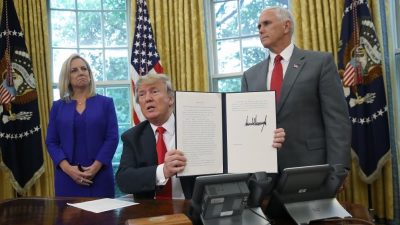Trump reverses course on separation of migrant families

The order was drafted by Homeland Security Secretary Kirstjen Nielsen in an effort to end what has become a major crisis for the Trump administration.
“We’re going to have very strong borders but we are going to keep families together,” the president said, adding that he doesn’t like seeing children separated from their families.
However, he also said that the ‘zero tolerance’ policy on illegal immigration will continue.
The order marks a dramatic departure for an administration that has been insisting, wrongly, that it has no choice but to separate families apprehended at the border because of the law and a court decision.
Al Jazeera’s White House correspondant Kimberly Halkett described the action as a “tremendous reversal of policy” but that the broader issue of immigration is still yet to be resolved.
“This is just a stop-gap measure to end the child separations,” she said. “Democrats and Republicans – although they are both blaming each other – have not resolved the broader issue of immigration reform that has been stymying this congress and law makers for about two decades or longer.”
Nielsen, the president and other officials have repeatedly said the only way to end the practice is for Congress to pass new legislation, though both Democrats and some Republicans have said the president could reverse it with a simple phone call.
The news in recent days has been dominated by searing images of children held in cages at border facilities, as well as audio recordings of young children crying for their parents.
Earlier on Wednesday, Trump blamed the Democrats for the impasse in Congress.
“It’s the Democrats fault, they won’t give us the votes needed to pass good immigration legislation,” he tweeted.
“They want open borders, which breeds horrible crime. Republicans want security.”
Trump signed an executive order on Wednesday detaining parents and children together [AFP]
Senator Jeff Merkley said that the exeuctive action does not necessarily reflect a positive solution.
“Details yet to come, but @realDonaldTrump’s ‘solution’ to family separation sounds like handcuffs for all,” he said in a post on Twitter.
“Locking up children and families in detention centers is unacceptable and un-American.”
Nicole AustinHillery, the US executive director at Human Rights Watch, agreed.
“[Republicans] in the Senate are now considering detaining families as a unit in response to the national outcry from tearing families apart,” she said.
“This is not a solution just a change in how the damage is done.”
Homeland Security officials did not immediately respond to requests for comment.
Zero tolerance
The administration recently put into place a “zero tolerance” policy in which all unlawful border crossings are referred for prosecution – a process that moves adults to the custody of the US Marshals Service and sends many children to facilities run by the Department of Health and Human Services.
Under the Obama administration, such families were usually referred for civil deportation proceedings, not requiring separation.
The policy had led to a spike in family separations in recent weeks, with more than 2,300 minors were separated from their families at the border from May 5 through June 9, according to the Department of Homeland Security.
Nielsen’s action would not end the zero tolerance policy, but would aim to keep families together and ask the Department of Defense to help house the detained families.
Nielsen is working with the other agencies, including the Justice Department, Health and Human Services and the law enforcement agencies within Homeland Security on the proposed changes.
The aim is to legally work around a settlement that prevents the detention of families together for more than 20 days, or defy the order and force it back into court to argue for changes to settlement.
The settlement of a class-action lawsuit set policies for the treatment and release of unaccompanied children who are caught at the border.
The Flores settlement, named for a teenage girl who brought the case in the 1980s, requires the government to release children from custody and to their parents, adult relatives or other caretakers, in order of preference.
If those options are exhausted, authorities must find the “least restrictive” setting for the child who arrived without parents.
In 2015, a federal judge in Los Angeles expanded the terms of the settlement, ruling that it applies to children who are caught with their parents as well as to those who come to the US alone.
Other recent rulings, upheld on appeal, affirm the children’s rights to a bond hearing and require better conditions at the Border Patrol’s short-term holding facilities.
In 2016, the Ninth US Circuit Court of Appeals ruled that child migrants who came to the border with parents and were held in custody must be released.
The decision did not state parents must be released. Neither, though, did it require parents to be kept in detention, apart from their children. (Al Jazeera)

